2007 VOLKSWAGEN GOLF oil
[x] Cancel search: oilPage 285 of 444
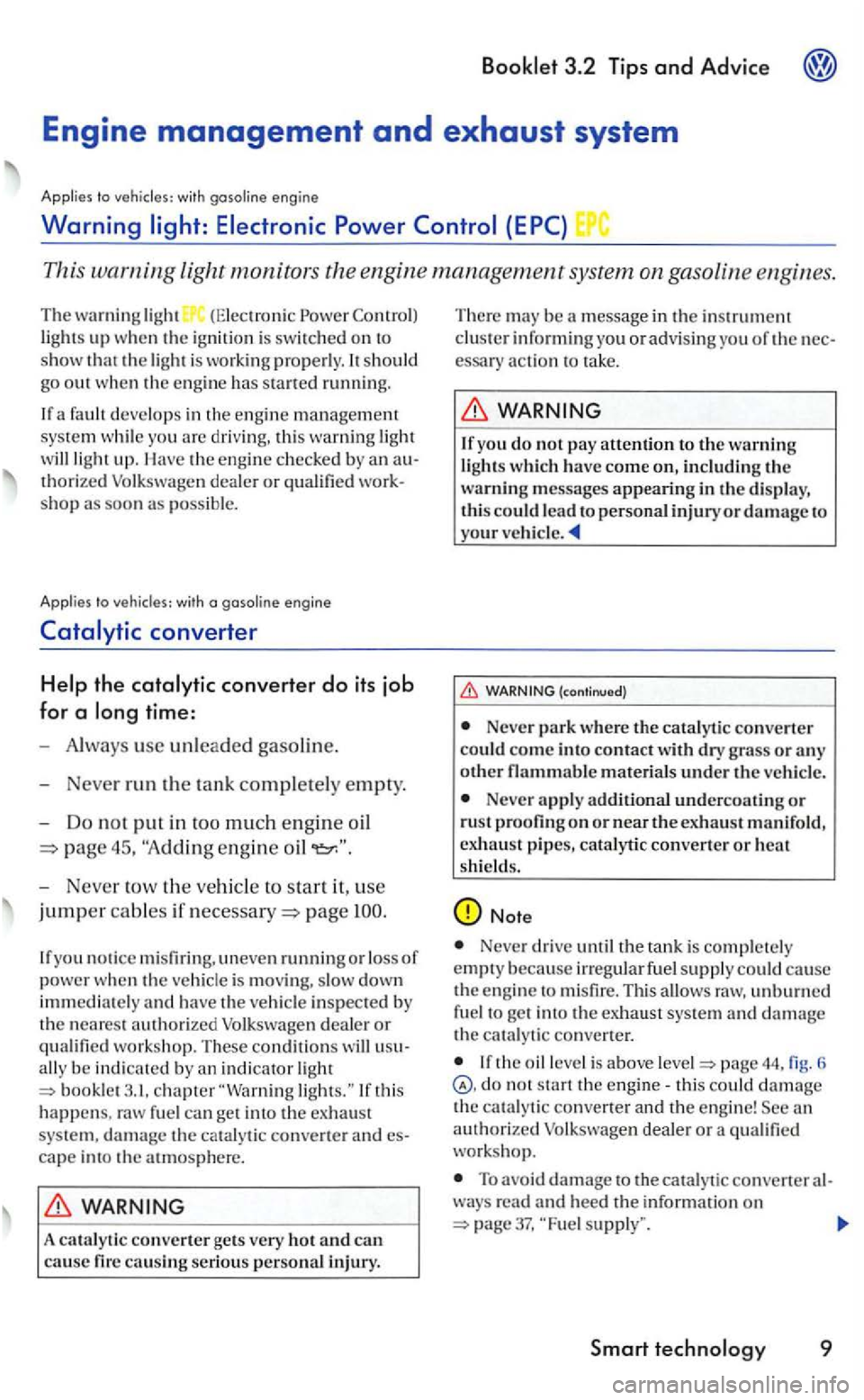
light monitors the
lights up when the ignit ion is sw itched on to
s how that the light is work ing properly. should
go ou t when the engin e ha s s tarted running.
a fault develops in the e ngin e management system while yo u are driving, thi s warning light
will light up. thorized dealer or qualified
the
t a nk completely empty.
- Do no t put in too much engine oil
45,
- Never tow the ve hicl e to sta rt use
jumper cables page
you notice misfiri ng, uneven running or loss of power whe n the vehicle is moving, slo w down
immedi at ely and have the ve hicle inspecte d b y the neares t authorized
chapter"Warning
cape int o the atmosphere.
A catalytic convert er ge ts very h ot and can
cause fir e causin g serious person al injury. Th
ere
may be a message in the in strument cluster inform ing you or advising you of th e essary ac tion to take.
yo u do not pay attention to the warning
li ghts which have come on, including th e warning messages appearing in th e d isplay, this could lead t o personal injury or damage to your vehic le.
(cont inued)
Never park whe re
Neve r apply additional undercoating or rust proofing o n or near the exhaust manifo ld,
ex hau st pipes, catalytic converter or heat s hi elds.
Note
Never drive until the tank is completely
e mpty becau se irregular fu el supply could cause the engine t o misfire. This allow s raw, unburned fu el to get into the ex haust sys tem and damage the catalytic conve rter.
the oil leve l is above page 44, fig. 6 not start the engine- t his could damage the catalytic co nverte r and the engine!
To avoid damage to the catalytic converter
37,
Page 288 of 444
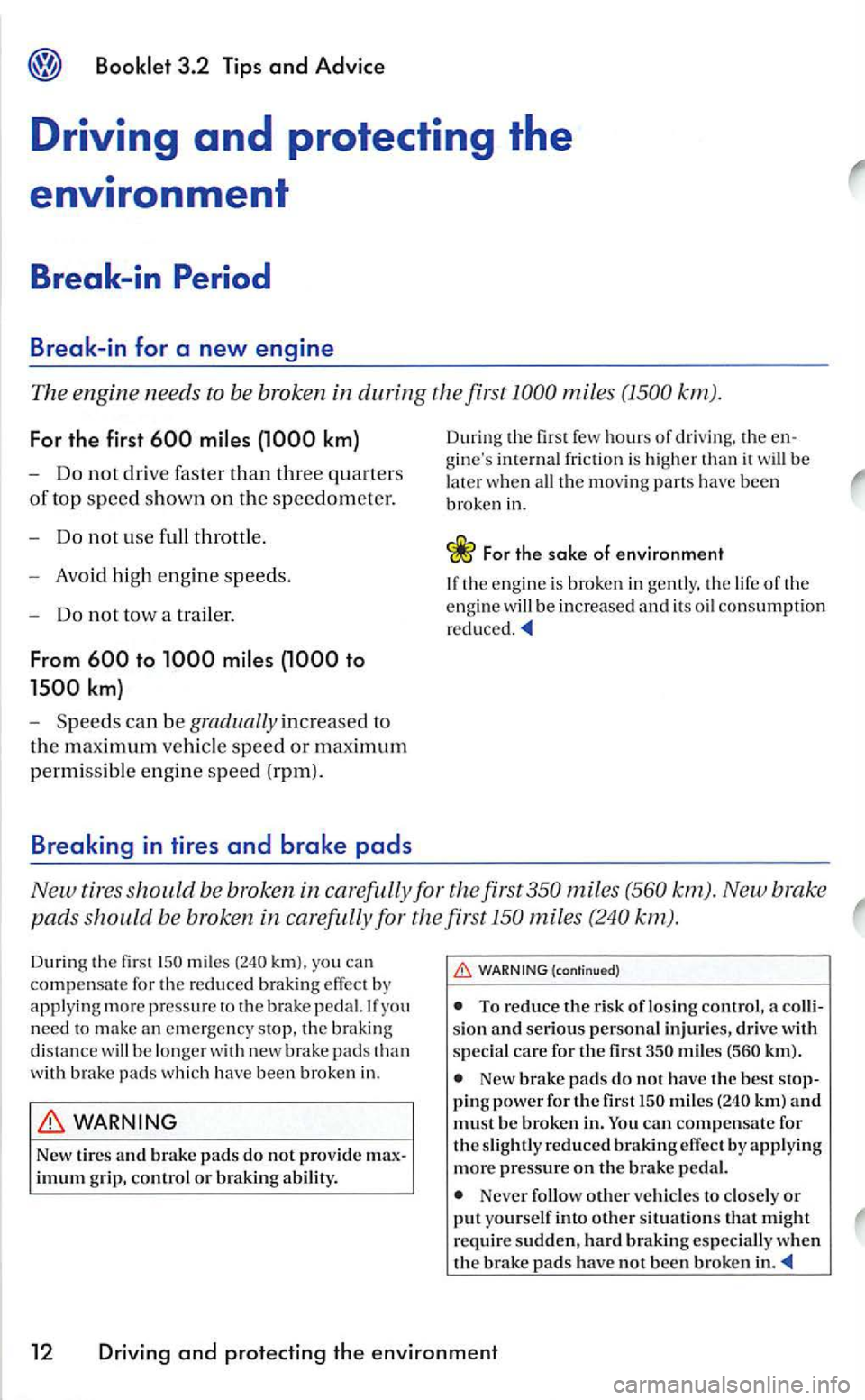
miles
can b e gradually in creased to
th e maximum vehicl e s
peed or maximum
permissibl e engin e speed (rpm ).
Breaking in tires and brake pads
Durin g the fir st few h o u rs of dri ving, the g ine 's inte rnal fric tion is hi gher than it will be
l a te r w he n a ll th e m ovin g part s have been bro ke n in.
For the sake of environment
th e eng in e is bro ke n in gentl y, the lif e of the engine will be in creased and it s oil co nsumption
New tires should be broken in carefull y for the fir st miles (560 km). New brake
pads b e broken in carefu lly for the first miles (240 km).
Durin g th e fir st miles km l. you can
c ompe nsate for the reduced brak ing effect by apply in g m ore press ure th e brake pedal.l fyo u
need to make a n em ergency slOp, the brak ing
di sta nce will b e longe r w ith new brake pads than
wit h brake pads wh ic h have been b roke n in.
WARNING
New tires and brake pads do not provide imum gri p, control o r braking
(cont;n ued)
To reduce the ri sk of losing a
miles
New brake pads do not have th e best pin g power for the fir st km) and must be broken in. can compe nsate for the s lightly reduced braking effect b y applying more pressure on the brake pedal.
N eve r follow other vehicles to clos ely or put yours elf into other situati on s that might require sudden, h a rd braking especially when the brake pads have not been broke n in.
12 Driving and protecting the environment
Page 289 of 444
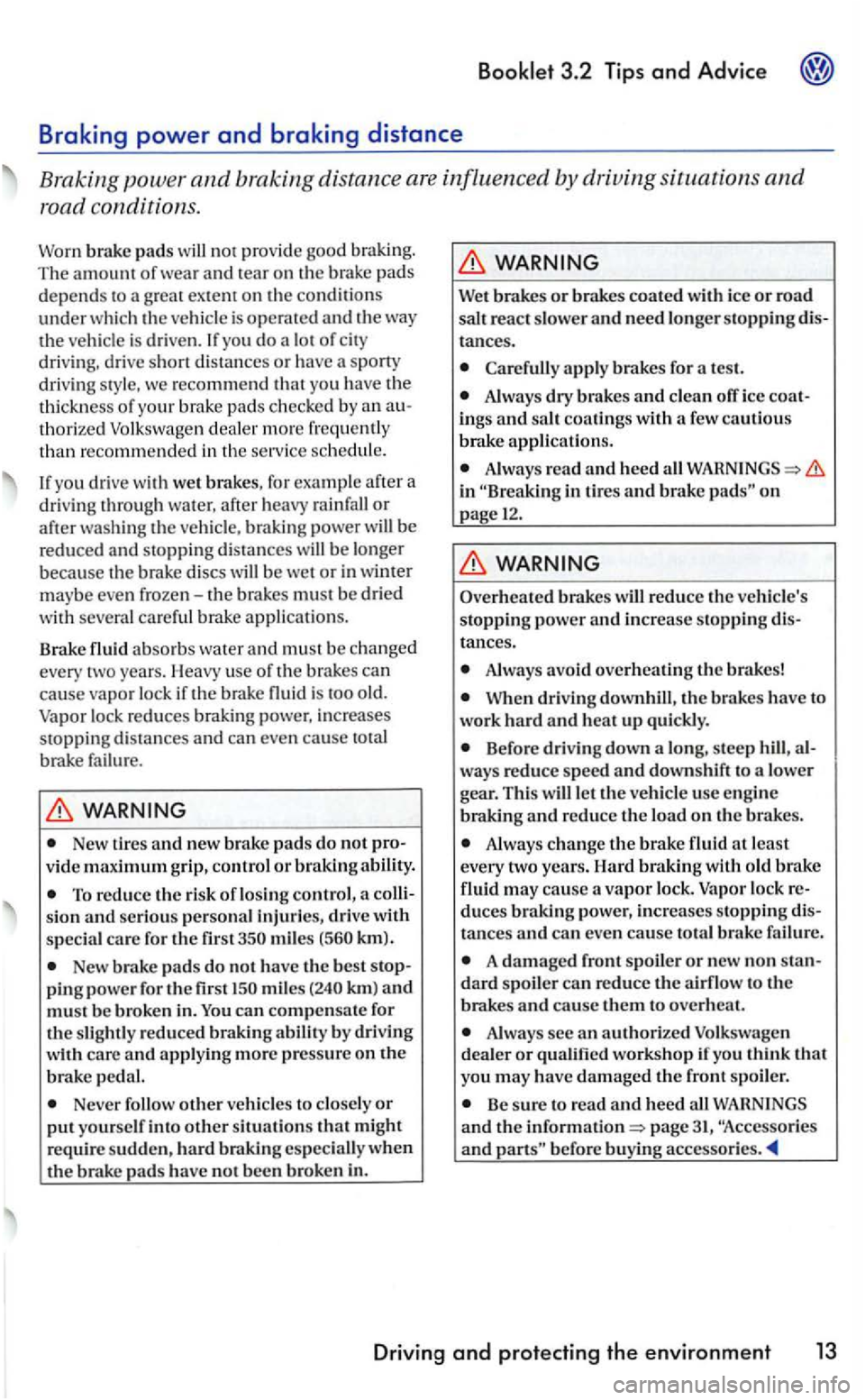
Booklet 3 .2 Tips and Advic e
recommend that you have the
thi ckne ss of your brake pads checked by an au
t horized Vol kswagen dealer mo re fre quent ly
t h an recommende d in the serv ice sched ule.
you drive with wet brakes, for example afte r a
dri ving through water, after heavy rainfall or after washing the ve hicle, braking power be
reduced and s to ppin g distances will be longer
because the brake discs will be we t or in winter mayb e eve n frozen-the brakes must be dried
with several ca re ful brak e applicatio ns.
Brak e fluid absor bs water
and must be changed
every two years. Heavy use of the brakes can cause vapor lock if the brake fluid is too old.
Vapor lock redu ces braking power, increases
stopping distances and ca n even cause total
brake failure.
New tires and new bra ke pads do no t pro
v id e m aximum gri p, control o r b raking abil ity.
To red uce the risk of l osi ng control, a s io n an d se rio us perso nal injuries, drive with
specia l ca re for the first 350 miles (560 km).
New brake pads do not have th e best sto p
ping power for the fir st ISO mile s (240 km ) and
m ust be b roken in. can compensate for the slightly reduced braki ng abil ity by dri ving care and applyin g more pressure on th e
brake pedal.
Never follow oth e r veh icles to close ly or
p u t you rse lf in to other s ituations th at might
requ ire su d den , hard bra king especially when the brake pads have not been broken in.
apply brakes for a test.
Always dry brakes and clea n off icc coat
i ngs an d salt coatings with a few cautious brake applications.
A lways read and heed in in tire s and brake on page 12.
Always avoid overheati ng the brakes!
When driving downhill, t11 e brakes have to
work har d and h eat up quickly.
Before driving down a lo ng, steep hill, al
ways reduce speed and downshift to a lower
gear. This will let the vehicle usc engine
Always ch ange th e brake fluid at l east
every two years. Hard braki ng wi th o ld flui d may cause a va po r lock . Vapor loc k duces powe r, inc reases stoppin g di stan ces and can even cause tota l b rak e failure.
A damaged front spoiler or n ew non standard spoiler can reduce t h e airflow to th e
brakes and cause them to ove rh eat.
Always see an authorized Volkswag en
dealer or qualified workshop
Be sure to re ad and heed all and th e page
Driving and protecting the environm ent 13
Page 295 of 444
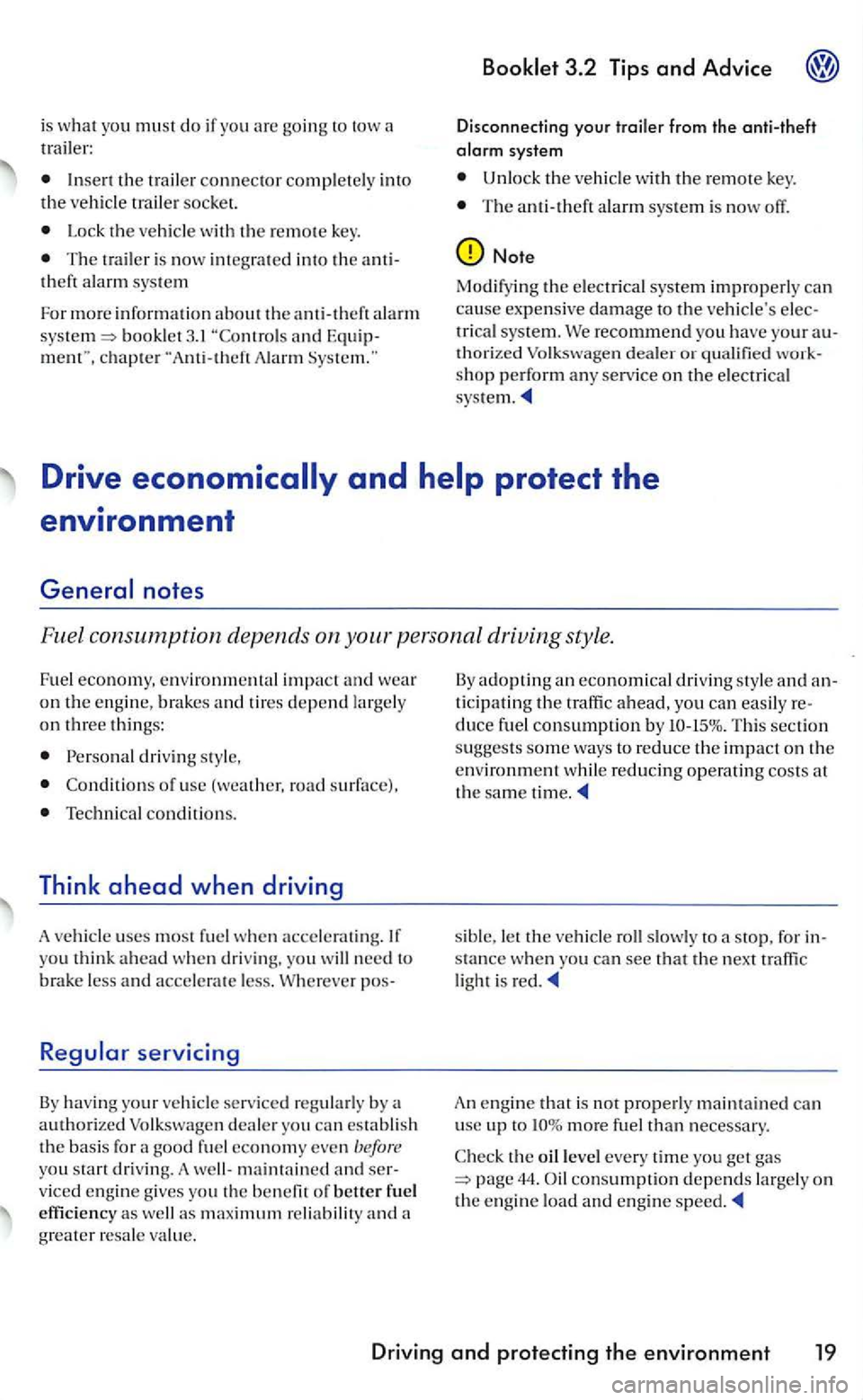
is what you mus t do if you going to tow
Inse rt the trailer connector completely into the vehicle trailer socket.
Lock th e ve hicle with the remote key.
The trail er is now integ rat ed int o th e theft alarm system
For more information about the anti-theft alarm bookl et3. 1 chapter "Anti -theft Alarm
Disco nnecting your trailer from the anti-th eft
alarm system
Unlock th e vehicle with the remote key.
The anti-theft alarm sys tem is now ofT.
Note
Mod ify ing the electrical system improperly can cause expe nsive damage to the veh icle's trical sys tem. recommend yo u have your thorized Vol kswagen dealer o r qualified
driving sty le,
Co nditions of use (wea ther, road s urface) .
Technical conditions.
Think ahead when driving
A ve hicl e uses most fuel when accel erating. If
yo u think ahead when driving. you need to brake less and accelerate less. pos-
Regular servicing
B y having your vehicle serviced regularly by a authorized dealer you can es tabl is h the basis for a good fuel economy even you start drivin g. v iced e ngine give s yo u th e be nefit of better fuel
efficie ncy as well as maximum re liabilit y and greater resale value. B
y
adopting an economica l driv ing style and ticipat ing the traffic ahead, you can easily duce fuel consumption by Thi s section sug ges ts som e w ays to reduce th e impact on th e
e nvironment while reduci ng operatin g costs at
the same
s ibl e, let the vehicle roll slo wly to a stop. for
light is
A n engine that is no t properly maintained can usc up to 10% more f uel than necessary.
the oil level every time you get gas consumption dep ends la rgely on the e ngin e load and engine
Driving and protecting the environment 19
Page 297 of 444
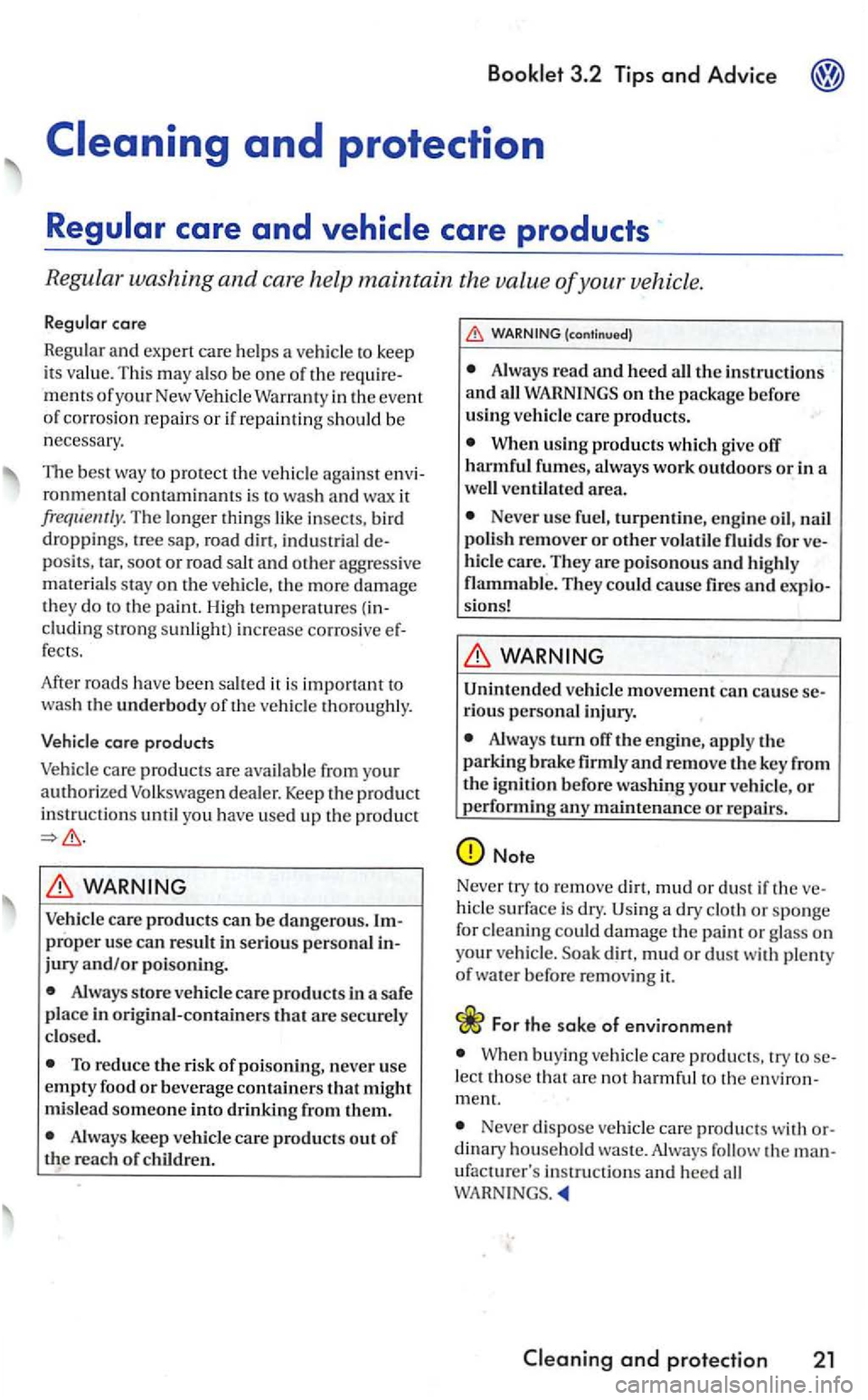
Booklet 3.2 Tips and Advice
ment s o f your New Veh icl e Warra nty in the eve nt
o f co rros io n r ep air s or if re paint in g sh ould be
n ecessary.
TI1e best way to p ro tec t th e veh icle against
T he lo nger thi ngs like insects. bird
d ro ppings. tree sap, roa d di rt, in d ust rial
cluding stro ng su nlight) increas e co rros ive f ec ts.
After roads have been sa lted it is impo rtant to
wash th e unde rbod y of th e veh icle thoroughly.
WARNING
Ve hicl e ca re produc ts ca n be dang erous. pro per use can result in seriou s pe rso na l jury and/or p oisoning .
Alw ays stor e ve hicle care produc ts in a safe
place in ori ginal -containers th at are securely
cl osed.
Always keep ve hicle care products out of th e reach of childr en .
(contin ued }
Alway s read and heed all the in stru ction s
and all
When u sing products which giv e off
harmful fumes, alway s work outdoors or in a
w ell ventilat ed area.
Neve r use fu el, turpentine, e n gin e oil, n ail poli sh re m ove r or other volatile fluids for hicl e care. Th ey are poi sonous and hi ghl y
flammabl e. Th ey could cause fires and
ve hicl e movement can ca use
Always turn off the engin e, apply th e parkin g brak e firmly and remove the key from the ig niti on b efor e w ashing your ve hicl e, o r
p erformin g any mainten ance or re p airs.
hicle su rface is dry.
For the sake of environment
When buying vehi cle care p rod uc ts, try to lec t th ose th a t are no t harmful to the m ent.
Neve r d is pose vehicle care prod ucts with din ary ho useho ld was te. Alway s follow th e u fact urer 's instruc tion s and heed all
Page 299 of 444
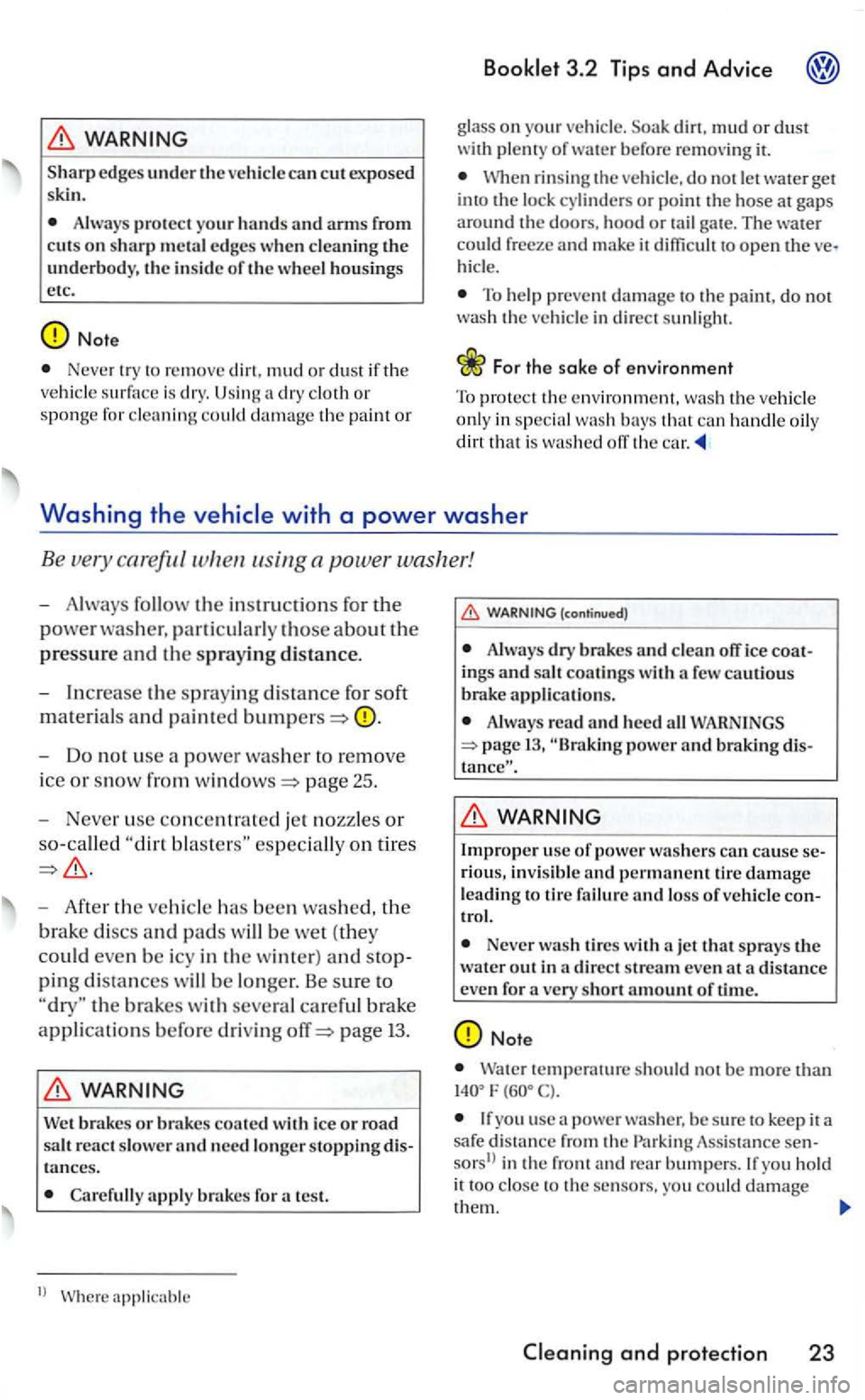
edges under the vehicl e can cut exposed
ski n.
Alway s protect your hands and arms from cuts on sharp m etal edges when clea ning th e underbody, the inside of th e wheel housin gs
etc.
Never try to remov e mud or dust if the vehicle dry . a dry cloth or
sponge fo r cleaning could damage th e paint or
3.2 Tip s and Advice
glass on your vehicle . dirt . mud or dust with plent y of wate r before removing it.
When rinsing the vehicle. do no t let water ge t
int o th e lock cylinders or point the hose at gaps
around the doors. hood or tail gate. The water could freeze and make it difficult to open the hicle.
To he lp preve nt damage to th e pai nt, do not was h the vehicle in direct sunl ight.
F o r th e sake of environment
To protect the environme nt. wash the vehicle
only in specia l was h bays that c an handle oily
d irt that is wash ed off th e car.
- Do nor use a power washer to remove
ic e
or snow page 25.
- Neve r use concentrated jet nozzles or
so-called
- After ve hicl e has been washed, the
brake
dis cs and pads will be we t (they
could even be icy in the win te r) and
th e brakes with seve ra l care ful brake
application s before drivin g page 13.
WARNING
brakes or bra kes coa ted with ice or road salt react slower and n eed longer stoppin g tances.
Ca re full y apply brake s for a test.
1
l ap plicab le
Always dry and cl ean off ice ings and salt coatings with a few cautious brake applicati ons.
Always rea d and heed all power and braking
WARNING
Improper usc of powe r was he rs ca n cause rious , in vis ible and perm an ent tire damage leading to tire failur e an d loss of ve hicle trol.
Never wa sh tire s wi th the water out in a direc t stream even at
temperature sh o uld not be more than F
If yo u use power wash e r. be sure to keep it a
sa fe d istance from the sors' > in the front and rear bumpers . you h old
it too to the sensors, you could damage
them.
and protection 23
Page 301 of 444
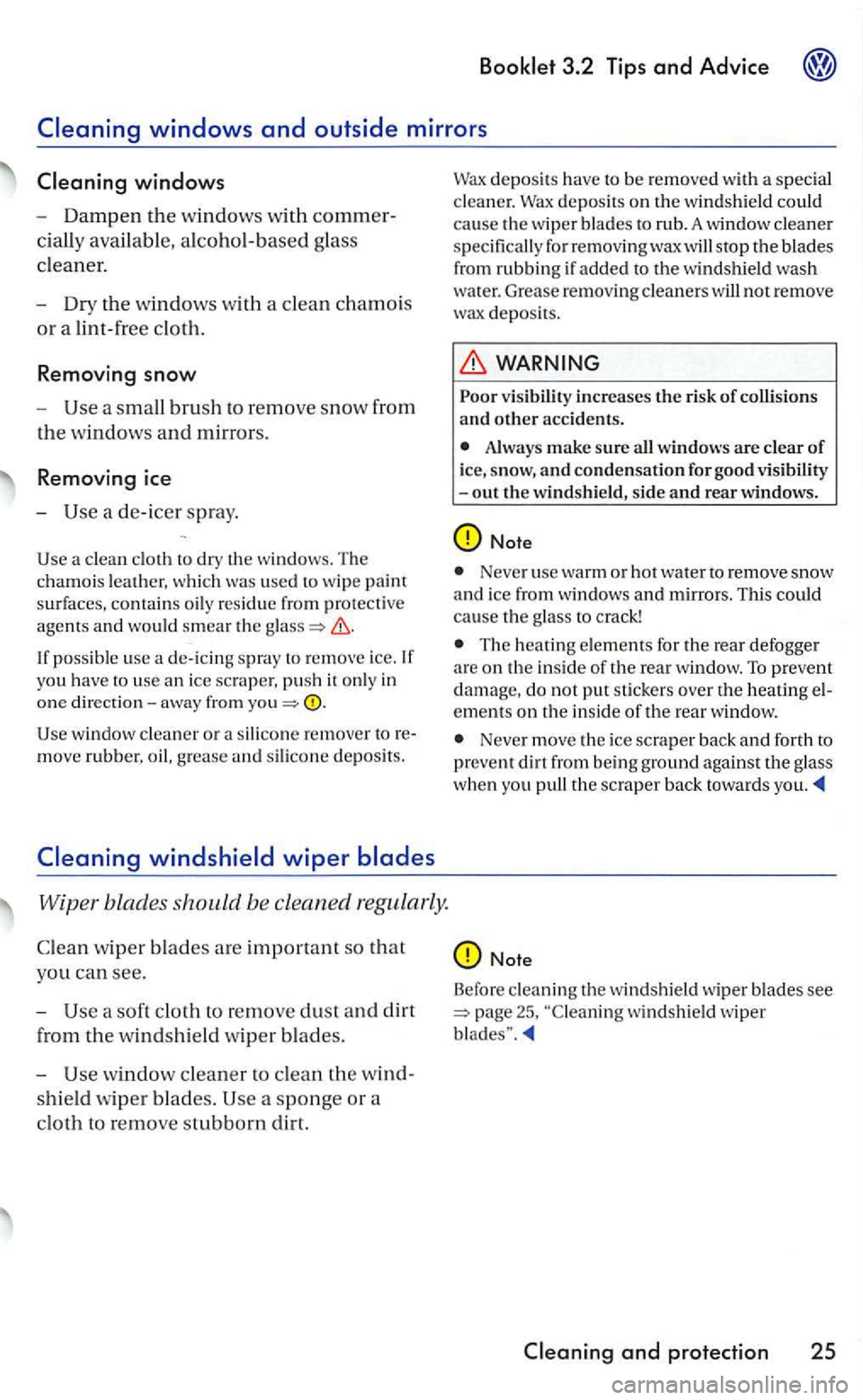
Booklet 3.2 Tips and Advice
Dampen the windows w ith commer
cially avai lable, alcohol-based g lass
clean er.
Dr y the windows with a clean chamois
or a lint-free cloth.
Removing snow
- Use a s mall brush to remov e snow from
the windows and mirror s.
Removing ice
-Use a de-i cer spra y.
U se a clean cloth to dry th e windows. The
c h amois leather, whic h was use d to wip e paint
surfaces, contains oily res idu e from protective
agents and would smear th e
poss ible use a de- ic in g spray to remove ice. you have to use an ice scraper, push it on ly in one dire ctio n- away from 0.
Use window cleane r or a silico ne remover to re
move rubber, oil, grease silicone depo sits.
Wiper blades should be cleaned regularly.
Clean wiper blades are important so that
y
ou can see.
- Use a so
ft cloth to re mov e dust and dirt
from the windshi eld wiper blades.
- U se window clean
er to clean the w ind
s hi eld wip er blad es. U se a s
ponge or a
cloth to re
move stubborn dirt.
Wax deposits have to be remove d with sp ecial
cleaner. Wax deposits on the windshield could cause the wiper blades to rub. A window clea ner sp ecifica lly for removing wax will stop the b lades
f rom rubbing if added to the windshie ld wash wa te r. Grease removing cleaners will not remove
wax deposits.
WARNING
Poor visi bili ty inc re ases the risk of collisions and oth er ac cid ent s.
Always make sure all win dows are clear of ice , snow , and cond ensation for goo d vis ibility -out the windshie ld, side and rear windows.
Never use warm or h ot water to re move snow and ice from wind ows and mirro rs. This could
ca use th e glass to crack!
The heati ng ele ment s for the rear defogger
a re on t h e in side of the rear window. To preve nt damage, do not put sticke rs over the heatin g e l
ements o n the in side of the rear w indow.
Never move the ice scraper back and forth to
p reve nt dirt from being ground against the gla ss
when you pull the sc raper back towa rds yo u.
Cleaning and protection 25
Page 302 of 444
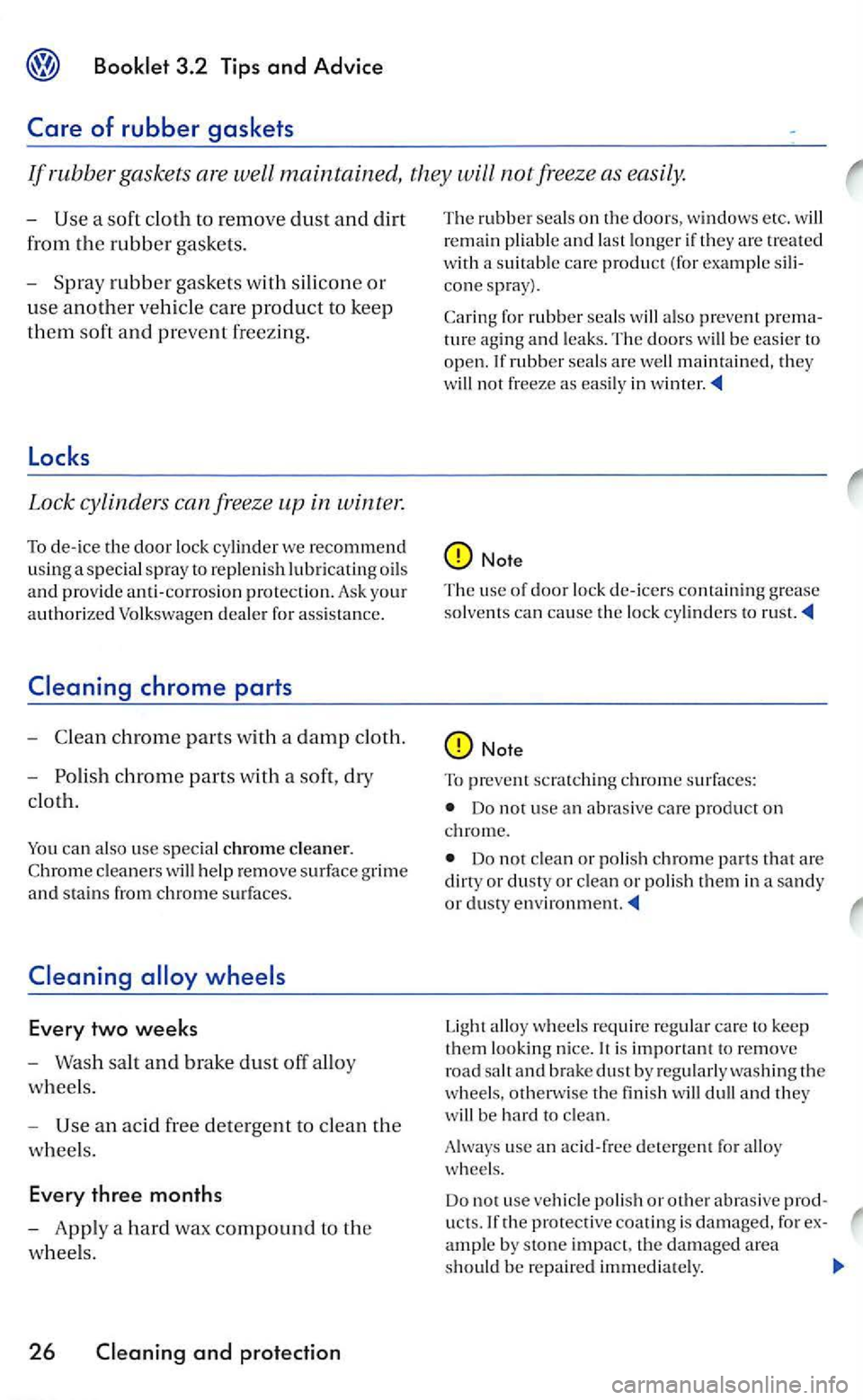
a soft cloth to re m ove dust and d irt
from
the rubber gaskets.
- Spray
rubber gaskets with silicone or
u
se another veh icle care product to kee p
them soft and p revent freez ing.
Locks
Lock cylinders can freeze up in winter.
To de-ice the door lock cylinder we recommend
using a sp e cia l spray to repl enish lubricatin g oils and pro vid e an ti- co rro sio n pro tect ion. Ask you r
authorized Volkswagen dea le r for ass istance.
ca n also use sp ecia l ch ro m e clea ner. cleaners will he lp remove surface grime and sta ins from chrome surface s.
an acid free dete rgent to clean the
w h
eels .
E very three months
- Apply a hard wax compound to the
w
heel s .
26
for rubber sea ls w ill also prevent pre mature aging and leaks. The doors will be easier to open. rubber seals are well maintained, they
will not freeze as easi ly in winter.
Note
The use of door lock de-icers contai ning grease
solvents can cause the lock cylinders to rust.
Note
To prevent scratching c hrome surface s:
Do not use an abrasive care prod uc t o n
chrome.
Do not clea n or polish chrome pa rts that are
dirty or dusty or clean or polis h them in a sandy or dusty environment.
Light alloy wheels require reg ular care to keep them look ing nice. is impor tant to remove
road salt and brake dust by regularly wash ing th e
wheels, other w ise th e finish will be hard to clean.
Always use
an acid-free detergent for alloy
w heels.
Do not use vehicle polish
or other abras ive prod
ucts. the protective coating is damaged, for example by stone im pact. the damaged area should be repaired immediately .